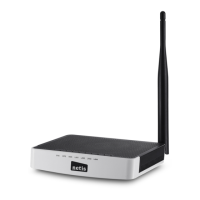
Do you have a question about the Netis WF2411 and is the answer not in the manual?
| VPN support | PPTP, L2TP, IPSEC |
|---|---|
| Ethernet LAN | Yes |
| Cabling technology | 10/100Base-T(X) |
| Networking standards | IEEE 802.11b, IEEE 802.11g, IEEE 802.11n, IEEE 802.3, IEEE 802.3u |
| Ethernet LAN data rates | 10, 100 Mbit/s |
| Ethernet LAN interface type | Fast Ethernet |
| Wi-Fi standards | 802.11b, 802.11g, Wi-Fi 4 (802.11n) |
| Top Wi-Fi standard | Wi-Fi 4 (802.11n) |
| WLAN data transfer rate (max) | 150 Mbit/s |
| Input current | 0.5 A |
| Rack mounting | No |
| Frequency band | 2.4 GHz |
| Frequency range | 2.4 - 2.4385 GHz |
| WLAN data transfer rates supported | 1, 2, 5.5, 6, 9, 11, 12, 18, 21, 24, 36, 48, 54, 65, 150 Mbit/s |
| Ethernet LAN (RJ-45) ports | 4 |
| DHCP client | - |
| Security algorithms | 128-bit WEP, 64-bit WEP, SSID, WPA-AES, WPA-PSK, WPA-TKIP, WPA2-AES, WPA2-PSK, WPA2-TKIP |
| Antennas quantity | 1 |
| Antenna gain level (max) | 5 dBi |
| Product color | Black, White |
| LED indicators | LAN, Power, WAN |
| Certification | FCC, CE, KC |
| Output voltage | 9 V |
| Power source type | DC |
| Storage temperature (T-T) | -40 - 70 °C |
| Operating temperature (T-T) | 0 - 40 °C |
| Storage relative humidity (H-H) | 5 - 90 % |
| Operating relative humidity (H-H) | 10 - 90 % |
| Cables included | LAN (RJ-45) |
| Depth | 99 mm |
|---|---|
| Width | 133 mm |
| Height | 27 mm |
| Weight | 149 g |
Explains FCC compliance for Class B digital devices and measures to correct interference.
Details FCC RF radiation exposure limits and compliance conditions.
Details copyright information and company trademarks.
Provides contact details for technical support in USA and Canada.
Provides a summary of the 150Mbps Wireless-N AP/Repeater/Router client's capabilities.
Lists the essential features and functionalities of the device.
Details the wireless and wired standards and protocols the router supports.
Specifies operating temperature, humidity, and power requirements for the device.
Lists the minimum requirements for hardware installation and setup.
Describes the front and rear panels of the router and their components.
Explains how to reset the router to its factory default settings.
Outlines the steps for physically installing the router hardware.
Step-by-step guide to configure Windows 98/Me for router login.
Step-by-step guide to configure Windows 2000 for router login.
Step-by-step guide to configure Windows XP for router login.
Step-by-step guide to configure Windows Vista for router login.
Step-by-step guide to configure Windows 7 for router login.
Step-by-step guide to configure Mac OS for router login.
Displays current operational status, including versions, WAN, LAN, and wireless information.
Offers a simplified method for configuring the router for internet access (DHCP, PPPoE, Static).
Guides on using WPS for easy and secure wireless network setup.
Provides settings for configuring network connections, including WAN and LAN parameters.
Configures wireless network parameters like SSID, security, and advanced options.
Manages DHCP server settings and client lists for IP address assignment.
Manages port forwarding rules and virtual server configurations.
Provides various security settings like IP filtering, MAC filtering, and domain filtering.
Configures static routes for network traffic forwarding.
Configures Quality of Service (QoS) to prioritize network traffic.
Configures DDNS to access the router using a domain name.
Provides tools for system management, including firmware upgrades, time settings, and password changes.
Guides on resolving issues accessing the router's configuration interface.
Explains how to reset the router to factory defaults if the password is forgotten.
Provides steps to check for problems related to cable modem connectivity.
Troubleshoots issues where the router's configuration utility is accessible but internet access fails.
Addresses problems with wireless clients communicating with other Ethernet computers.